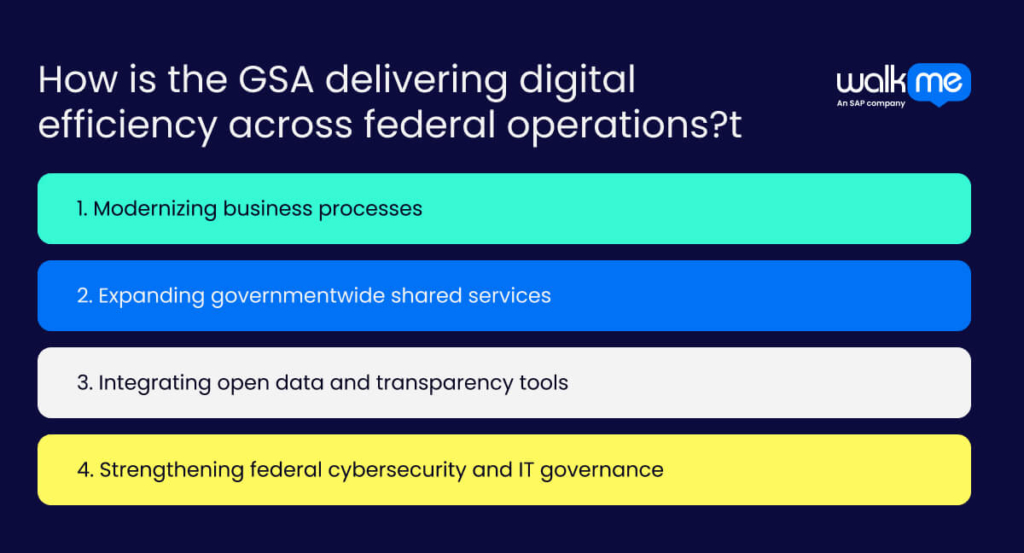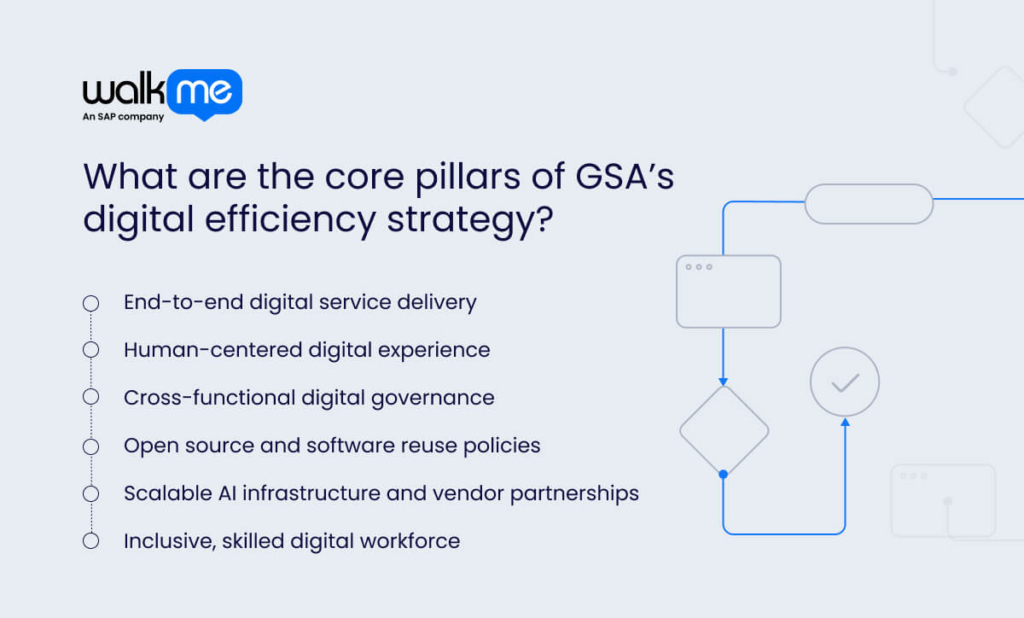Public trust is closely tied to the government’s performance, and the General Services Administration (GSA) is now one of the most important forces behind digital efficiency in the public sector.
GSA connects procurement, technology, and real estate to speed up delivery and reduce costs across federal departments.
Its focus on interoperability, zero-trust architecture, and AI readiness is helping modernize government infrastructure, leading to faster, more reliable services.
From FedRAMP digital transformation to the Technology Modernization Fund, GSA is building smarter services that scale. However, as fiscal pressures rise with growing public expectations, it must maintain velocity while remaining transparent and agile.
This article examines how the GSA is driving digital efficiency in government and setting the standard for scalable, inclusive innovation.
What is digital efficiency in the General Services Administration?
Digital efficiency at the General Services Administration (GSA) means using more intelligent technology and processes to deliver federal services faster, safer, and more cost-effectively.
To explain how digital efficiency works at the GSA, we’ll highlight two examples below that show how the agency is cutting processing times through cloud-based acquisition platforms and improving cross-agency collaboration by modernizing legacy systems:
OneGov Cloud Savings
GSA’s OneGov agreements with Elastic and Oracle secure up to 60% and 75% discounts, respectively, on cloud and data tools. Centralizing contracts and leveraging volume discounts, GSA helps agencies deploy modern systems at a fraction of the usual cost, showing how strategic procurement drives efficient technology adoption.
Data Center Consolidation
Following the Data Center Optimization Initiative (DCOI), GSA closed numerous underused data centers and transitioned workloads to the cloud. This reduced physical infrastructure, improved energy use, and cut management overhead, saving taxpayer funds while freeing up resources for digital upgrades.
These examples illustrate how the GSA supports federal agencies in developing agile and cost-effective digital infrastructure. Readily deployable tools and thoughtful modernization strategies make digital efficiency a practical reality.
Why does digital efficiency matter for the GSA and its partner agencies?
Digital efficiency matters to the GSA because it helps the government work faster, smarter, and with fewer errors.
The GSA supports more than 400 federal agencies, so even small improvements can have a significant impact. For example, tools like eBuy expedite the review and approval process of contracts, reducing wait times and allowing staff to focus on more critical tasks.
Digital systems also go a long way in improving security. Login.gov gives millions of people one safe, verified way to access government services, instead of signing in to each agency separately.
Behind the scenes, IT process automation removes repetitive steps and connects systems, saving time and lowering department costs. This makes the whole government more reliable, especially during emergencies when services need to scale quickly.
Investing in digital efficiency means the GSA helps every agency deliver better public services. It also improves transparency, keeps data safer, and ensures tax dollars are used wisely and with accountability.
How is the GSA delivering digital efficiency across federal operations?

Now that you understand what GSA digital efficiency means and why it matters, we’re going a layer deeper to explore how the GSA delivers it across its operations.
Because the GSA supports over 400 federal departments and agencies, it’s essential to streamline processes and remove digital barriers at scale.
After reading this section, you’ll gain a clear view of how the GSA uses automation technology and shared platforms to boost performance, reduce duplication, and serve the public more effectively.
Modernizing business processes
The GSA’s FAS Catalog Platform updates vendor product listings in just one or two days. Before, this could take weeks. According to the GSA’s FY 2024 report, this automation reduces delays, cuts paperwork, and helps agencies make quicker purchases. Vendors can then update pricing and products more easily, and buyers get what they need without back-and-forth admin work.
Expanding governmentwide shared services
Login.gov handles over 40 million sign-ins every month across nearly 50 government agencies. Instead of building separate logins, agencies can use one secure system. This saves time and money while improving access for users. People only need one account to apply for jobs, benefits, or services.
Integrating open data and transparency tools
GSA’s Open Data site offers over 312,000 datasets and developer tools. Through open.gsa.gov and Data.gov, anyone can explore real-time data about spending, operations, or government services. This helps the public, researchers, and civic tech groups hold agencies accountable and design better tools based on real data.
Strengthening federal cybersecurity and IT governance
GSA adheres to strict security standards established by NIST and monitors systems in real-time as part of its ISCM strategy. It also runs the Federal IT Dashboard, which tracks $102 billion in federal IT spending. These tools ensure systems remain secure and that agency leaders make informed, cost-effective technology decisions.
What are the core pillars of GSA’s digital efficiency strategy?

This section breaks down the core pillars of digital efficiency at the GSA, focusing on how its technology and IT frameworks drive large-scale digital transformation. We highlight key elements of the GSA’s strategy to help you understand the complexities involved in streamlining operations and improving service delivery.
End-to-end digital service delivery
GSA focuses on seamless digital processes that simplify government purchasing from start to finish. The eOffer system streamlines vendor submissions for government contracts online, reducing paperwork and speeding up the approval process. This digital process cuts procurement time by weeks, helping agencies access services more quickly while ensuring transparency and compliance.
Human-centered digital experience
The agency prioritizes user-friendly designs that make government services easier and clearer for everyone. For example, the GSA’s 18F team works directly with users to redesign government tools, such as improving the SAM.gov registration process. Their focus on clear language and simpler navigation reduces confusion and errors, making it easier for businesses to compete for federal contracts. This user-first design approach also enhances satisfaction and participation.
Cross-functional digital governance
The Federal Risk and Authorization Management Program (FedRAMP), managed by GSA, coordinates security standards across agencies. It ensures that cloud services meet strict security rules before agencies use them, thereby reducing duplication and enhancing trust in shared technologies across the government. This governance helps agencies adopt secure tech faster and with confidence.
Open source and software reuse policies
The GSA leads efforts to unify security and technology standards across federal agencies for improved collaboration. GSA’s open-source platform, the Federal Source Code Policy, requires agencies to share at least 20% of new custom code publicly. This promotes the reuse of software, such as the Federalist web hosting tool, which cuts costs and speeds up digital projects while encouraging collaboration across the government.
Scalable AI infrastructure and vendor partnerships
GSA builds flexible AI tools by partnering with trusted vendors to improve services and efficiency. The GSA AI Center partners with agencies to create AI-powered chatbots that assist public inquiries, such as the VA’s virtual assistant. These scalable AI transformations reduce workload on staff and improve citizen access to services, while GSA vets vendors to ensure ethical AI use.
Inclusive, skilled digital workforce
GSA’s Tech Talent Initiative recruits veterans, students, and underrepresented groups into digital government roles. Through apprenticeships and fellowships, diverse professionals learn federal tech challenges while helping modernize systems. This helps build inclusion and creates a stronger, more representative government tech workforce.
How is GSA supporting smaller agencies in achieving digital efficiency?
This section explores how the GSA supports smaller agencies in becoming more digitally efficient. It’s important because, as mentioned earlier, the GSA oversees over 400 government departments and plays a central role as an enabler and connector.
Democratizing shared services
The GSA gives smaller agencies access to tools they couldn’t afford alone, like cloud storage, HR systems, or secure email platforms. Pooling resources through shared services enables agencies to save both time and money. This approach also levels the playing field, allowing even the smallest offices to run with big-agency efficiency.
Enabling flexible IT procurement
Instead of navigating long, complex contracts, smaller agencies can use GSA’s pre-approved vendor lists and fast-track purchasing platforms. These tools simplify buying tech like software or cybersecurity tools. The GSA’s flexible options help small teams obtain what they need more quickly, without requiring a full legal or procurement department.
Reducing barriers through open frameworks
Open frameworks let smaller agencies build on existing standards rather than start from scratch. GSA provides ready-to-use templates, coding tools, and data models that adhere to federal regulations. This saves time and avoids mistakes. It also ensures systems work together, so agencies can share data and collaborate more easily.
How does GSA build trust through transparency and accountability?
This section explores how the GSA builds trust through transparency and accountability, a nuanced and evolving area. While practices may shift over time, it’s important to consider how open data, performance tracking, and public reporting help build confidence.
Publishing open data performance dashboards
The GSA shares open data dashboards that display the performance of digital services. These tools let anyone see metrics like website speed or user satisfaction. Making this data public, the GSA holds itself accountable and helps agencies build trust through clear, measurable results.
Driving open source standards
Instead of locking technology behind closed systems, the GSA promotes the use of open-source software. This means others can inspect, reuse, or improve code freely. It reduces costs, prevents vendor lock-in, and lets the public see exactly how systems work, creating transparency that encourages collaboration and public confidence.
Sharing progress on public service goals
The GSA regularly updates the public on its goals, such as improving customer experience and reducing paperwork. These updates include what’s working, what’s delayed, and why. By clearly communicating progress (or setbacks), the GSA shows it’s serious about results and earns trust by not hiding behind vague promises.
What trends will shape GSA’s digital efficiency over the next decade?
Looking ahead, the GSA is laying the groundwork for next-gen digital infrastructure that can adapt to future demands.
We can expect to see a deeper integration of AI to automate tasks, expedite services, and enhance decision-making. Stronger data architecture flows between agencies will help reduce duplication and deliver faster support to the public.
But efficiency won’t come at the cost of equity, privacy, or sustainable technology. These principles remain front and center as systems evolve. The GSA’s long-term focus is clear. They aim to establish a modern digital government that serves everyone, across all devices, departments, and communities.
FAQs
Many agencies still rely on outdated systems that are hard to upgrade. Others lack the staff or funding to keep up with rapid tech changes. The GSA must strike a balance between speed and security while helping over 400 departments adopt modern tools without disrupting critical public services.
Open-source tools save money and avoid duplication by allowing agencies to build on existing code. Shared services like login.gov reduce the need for each agency to create its own platforms. This streamlines digital work, speeds up service delivery, and helps smaller departments tap into modern tools without starting from scratch.
GSA focuses on safe, responsible AI that improves public services, not just internal efficiency. Its AI tools are built with transparency and privacy in mind. GSA also works closely with vendors and teams across government to ensure automation helps agencies deliver faster, more accurate services that people can trust.

